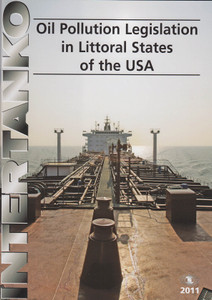
This publication covers the processes of planning, inspecting and repairing steel tanker structures and any protective coatings or protection systems. The practices and procedures described can be applied to both single and double hulled tankers and recommendations apply to oil tankers of any size and configuration.
This publication outlines key considerations for tanker inspections, from preparation and execution to result analysis. It also explains the causes, types and control of tanker corrosion. Guidance is informed by, though does not fully meet, requirements of the ISM Code. The manual offers methods by which a systematic maintenance programme can be established for tanker structures.
Many
regulations
and
publications
on
the
survey
and
operation
of
tankers
require
that
the
owner
or
manager
applies
‘effective
maintenance’
or
‘normal
maintenance’
to
the
ship’s
structure.
The
documentation
required
for
planning
Class
renewal
surveys
includes
records
of
owners’
inspections,
which
are
to
form
part
of
the
survey
report
file
on
board.
The
certificates
issued
by
some
Classification
Societies
state
that
the
ship
is
classed
‘subject
to
normal
maintenance’.
However,
when
asking
different
tanker
owners
what
they
understood
by
‘normal
maintenance’,
all
had
different
interpretations.
It
became
apparent
that
there
is
no
internationally
accepted
concept
of
‘normal
maintenance’.
If
an
owner
adopts
the
practices
laid
out
in
this
manual,
they
should
be
confident
that
they
will
meet
the
ISM
requirement
to
establish
procedures
that
ensure
the
ship’s
structure
conforms
to
the
provisions
of
relevant
rules
and
regulations.
This
guide
covers
the
maintenance
of
structural
steel,
together
with
its
coatings
or
other
corrosion
protective
system.
It
does
not
cover
such
items
as
propellers
and
machinery
items,
which
are
also
usually
given
attention
at
routine
survey
intervals.
Reference
is
made
to
the
requirements
of
the
ISM
Code,
which
also
requires
a
methodical
approach
to
the
maintenance
of
essential
equipment
and
machinery.
This
guide,
which
is
confined
to
maintenance
of
the
structure,
will
by
itself
therefore
not
fully
meet
the
ISM
requirements.
Effective
maintenance
depends
on
the
current
condition
of
the
structure
–
steel
in
poor
condition
will
require
more
frequent
inspections
than
steel
in
good
condition.
Furthermore,
there
must
be
a
minimum
standard
below
which
the
structure
is
unacceptable
to
both
the
Classification
Society
and
a
potential
charterer.
Many owners may already have established effective means of maintaining their ships’ structures. It is certainly not proposed that these should be replaced by the methods suggested in this publication, as what works for one company may not work for another. Likewise, owners without a formal maintenance plan may find that the approach described in this manual would not work for them. We encourage all owners to adopt a methodical approach to the maintenance of ships’ structures.
Chapter 1 Introduction
Chapter
2
Regulatory
Requirements
for
Maintenance
2.1
Introduction
2.2
International
Maritime
Organization
Conventions
2.3
Classification
Rules
Chapter
3
Review
of
Typical
Defects
3.1
Corrosion
3.2
Structural
Elements
Important
for
Global
Strength
3.3
Local
Strength
Issues
Chapter
4
Inspection
and
Maintenance
Objectives
4.1
Benefits
and
Challenges
4.2
Vessel
Age,
Design,
Operational
Profile
and
Cargoes
Factors
affecting
Scope
of
Inspection
Chapter
5
Inspection
Programmes
5.1
The
Inspection
and
Maintenance
Plan
(IMP)
5.2
Development
of
the
Inspection
and
Maintenance
Plan
(IMP)
5.3
Inspection
Preparation
5.4
Inspection
Execution
5.5
Inspection
Reports
5.6
Inspection
Result
Analysis
5.7
Acceptance
Criteria
5.8
Revision
of
IMP
Chapter
6
Maintenance
and
Repair
of
the
Hull
Structure
6.1
Scope
6.2
General
Requirements
6.3
Steel
Repair
Practice
and
Quality
Standard
Chapter
7
Protection
Against
Corrosion
7.1
The
Causes
and
Types
of
Corrosion
7.2
Corrosion
Control
7.3
Composite
Systems
–
Brief
Overview
7.4
Specific
Shipboard
Applications
and
Conditions
7.5
Cathodic
Protection
Systems
7.6
IACS
Guidelines
for
In
Service
Monitoring
Reports
7.7
Repairs
In
Service
–
In
Service
Maintenance
of
Coating
Systems
Appendix
1
Pitting
Intensity
Diagrams
Appendix 2 Example of an Inspection and Maintenance Plan, including Sample Report Forms for Copying
Appendix
3
Designing
for
Ease
of
Inspection
and
Maintenance
Appendix
4
Examples
of
Permanent
Means
of
Access
Appendix
5
List
of
Standards
in
Preparation
and
Coating
Appendix
6
Definition
of
‘Areas
under
Consideration’
TCSF
The
Tanker
Structure
Co-operative
Forum
(TSCF)
is
an
informal
technical
body
whose
membership
is
voluntary
and
comprised
of
Oil
Companies,
Independent
Owners/Operators
and
Classification
Societies
who
will
actively
contribute
to
the
TSCF’s
Mission.
The
mission
of
the
TSCF
is
to
advance
maritime
safety
through
improvements
in
the
design
and
maintenance
of
tanker
structures.
This
is
achieved
by
sharing
technical
knowledge
and
experience
in
order
to
gain
a
better
understanding
of
the
safety
performance
of
tanker
structures
in
service.
Specific
topic
areas
of
interest
include
corrosion,
structural
defects,
inspection
procedures,
and
criteria
for
determining
renewal
of
damaged
or
corroded
structure.
The
TSCF
is
committed
to
sharing
accumulated
experience
on
tanker
structures
with
the
marine
industry.
This
is
achieved
through
prompt
public
release
of
technical
manuals
and
information
papers,
and
proceedings
of
TSCF
Shipbuilder’s
Meetings.
http://www.tscforum.org/AboutTSCF/interim.aspx
INTERTANKO
INTERTANKO (the International Association of Independent Tanker Owners) is a trade association that has served as the voice for independent tanker owners since 1970, representing the interests of its Members at national, regional and international levels.
The organisation champions an industry dedicated to support global energy networks by delivering safe, efficient and environmentally sound transport services.
INTERTANKO actively works on a wide range of operational, technical, legal and commercial issues affecting tanker owners and operators around the world. It draws on regular and direct contact with its Members and other industry stakeholders to develop and disseminate information and best practice, essential to the tanker industry.
- Number of Pages:
- 90
- Published Date:
- January 2008
- Binding Format:
- Paperback
- Book Height:
- 300 mm
- Book Width:
- 210 mm
- Weight:
- 0.6 kg
- Author:
TCSF and INTERTANKO
- Preview:
- Yes





